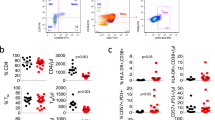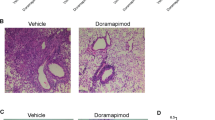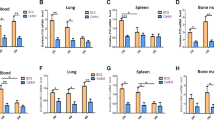Abstract
Immunosuppressive mediators in tuberculosis pleurisy (pleural fluid (PF)) are associated with the course of disease, but they remain poorly defined. To study the local immune status of patients with tuberculosis pleurisy, we examined the effect of PF on the functions of T cells and the differentiation of Th1 cells. PF could inhibit the ability of T cells to produce cytokines. However, tumor-necrosis factor (TNF)-α derived from non-T cells was not impaired. Further analysis indicated that cell activation and cell cycle progression were also suppressed. Moreover, PF could inhibit Th1 cell differentiation. Importantly, we found that inhibitors of indoleamine 2,3-dioxygenase (IDO) and adenosine and neutralizing antibodies against IL-10 and transforming growth factor (TGF)-β could reverse cytokine production, suggesting that IDO, adenosine, IL-10 and Transforming growth factor–β1 in PF might take part in impairing T-cell functions. Taken together, our data demonstrate for the first time that several immunopathological factors participate in the downregulation of T-cell functions in local PF.
This is a preview of subscription content, access via your institution
Access options
Subscribe to this journal
Receive 12 digital issues and online access to articles
$119.00 per year
only $9.92 per issue
Buy this article
- Purchase on Springer Link
- Instant access to full article PDF
Prices may be subject to local taxes which are calculated during checkout







Similar content being viewed by others
References
Ferrer J . Pleural tuberculosis. Eur Respir J 1997; 10: 942–947.
Porcel JM . Tuberculous pleural effusion. Lung 2009; 187: 263–270.
Light RW, Macgregor MI, Luchsinger PC, Ball WJ . Pleural effusions: the diagnostic separation of transudates and exudates. Ann Intern Med 1972; 77: 507–513.
Aleman M, de la Barrera SS, Schierloh PL, Alves L, Yokobori N, Baldini M et al. In tuberculous pleural effusions, activated neutrophils undergo apoptosis and acquire a dendritic cell-like phenotype. J Infect Dis 2005; 192: 399–409.
Saka H, Shimokata K . State of the art: treatment of malignant pleural and pericardial effusions. Gan To Kagaku Ryoho 1997; 24( Suppl 3): 418–425. Japanese.
Schwander SK, Torres M, Carranza CC, Escobedo D, Tary-Lehmann M, Anderson P et al. Pulmonary mononuclear cell responses to antigens of Mycobacterium tuberculosis in healthy household contacts of patients with active tuberculosis and healthy controls from the community. J Immunol 2000; 165: 1479–1485.
Bonecini-Almeida MG, Ho JL, Boechat N, Huard RC, Chitale S, Doo H et al. Down-modulation of lung immune responses by interleukin-10 and transforming growth factor beta (TGF-beta) and analysis of TGF-beta receptors I and II in active tuberculosis. Infect Immun 2004; 72: 2628–2634.
Mellor A . Indoleamine 2,3 dioxygenase and regulation of T cell immunity. Biochem Biophys Res Commun 2005; 338: 20–24.
Zeller JC, Panoskaltsis-Mortari A, Murphy WJ, Ruscetti FW, Narula S, Roncarolo MG et al. Induction of CD4+ T cell alloantigen-specific hyporesponsiveness by IL-10 and TGF-beta. J Immunol 1999; 163: 3684–3691.
Stone TW, Darlington LG . Endogenous kynurenines as targets for drug discovery and development. Nat Rev Drug Discov 2002; 1: 609–620.
Sitkovsky MV . Use of the A2A adenosine receptor as a physiological immunosuppressor and to engineer inflammation in vivo. Biochem Pharmacol 2003; 65: 493–501.
Driver AG, Kukoly CA, Ali S, Mustafa SJ . Adenosine in bronchoalveolar lavage fluid in asthma. Am Rev Respir Dis 1993; 148: 91–97.
Huszar E, Vass G, Vizi E, Csoma Z, Barat E, Molnar VG et al. Adenosine in exhaled breath condensate in healthy volunteers and in patients with asthma. Eur Respir J 2002; 20: 1393–1398.
Huszar E, Horvath I, Barat E, Herjavecz I, Boszormenyi-Nagy G, Kollai M . Elevated circulating adenosine level potentiates antigen-induced immediate bronchospasm and bronchoconstrictor mediator release in sensitized guinea pigs. J Allergy Clin Immunol 1998; 102: 687–691.
Jalapathy KV, Prabha C, Das SD . Correlates of protective immune response in tuberculous pleuritis. FEMS Immunol Med Microbiol 2004; 40: 139–145.
Barnes PF, Lu S, Abrams JS, Wang E, Yamamura M, Modlin RL . Cytokine production at the site of disease in human tuberculosis. Infect Immun 1993; 61: 3482–3489.
Condos R, Rom WN, Liu YM, Schluger NW . Local immune responses correlate with presentation and outcome in tuberculosis. Am J Respir Crit Care Med 1998; 157: 729–735.
Hernandez-Pando R, Orozco H, Aguilar D . Factors that deregulate the protective immune response in tuberculosis. Arch Immunol Ther Exp (Warsz) 2009; 57: 355–367.
Ho JL, Lapa ES . Promotion of a down-modulated lung immune state may be a strategy by M. tuberculosis to foster active disease and persistence. Discov Med 2010; 9: 34–41.
Zhu J, Yamane H, Paul WE . Differentiation of effector CD4 T cell populations. Annu Rev Immunol 2010; 28: 445–489.
Collins HL, Kaufmann SH . The many faces of host responses to tuberculosis. Immunology 2001; 103: 1–9.
Sahiratmadja E, Alisjahbana B, de Boer T, Adnan I, Maya A, Danusantoso H et al. Dynamic changes in pro- and anti-inflammatory cytokine profiles and gamma interferon receptor signaling integrity correlate with tuberculosis disease activity and response to curative treatment. Infect Immun 2007; 75: 820–829.
Taha RA, Kotsimbos TC, Song YL, Menzies D, Hamid Q . IFN-gamma and IL-12 are increased in active compared with inactive tuberculosis. Am J Respir Crit Care Med 1997; 155: 1135–1139.
Taylor MW, Feng GS . Relationship between interferon-gamma, indoleamine 2,3-dioxygenase, and tryptophan catabolism. FASEB J 1991; 5: 2516–2522.
Hwu P, Du MX, Lapointe R, Do M, Taylor MW, Young HA . Indoleamine 2,3-dioxygenase production by human dendritic cells results in the inhibition of T cell proliferation. J Immunol 2000; 164: 3596–3599.
Mellor AL, Munn DH . IDO expression by dendritic cells: tolerance and tryptophan catabolism. Nat Rev Immunol 2004; 4: 762–774.
Sitkovsky MV, Lukashev D, Apasov S, Kojima H, Koshiba M, Caldwell C et al. Physiological control of immune response and inflammatory tissue damage by hypoxia-inducible factors and adenosine A2A receptors. Annu Rev Immunol 2004; 22: 657–682.
Zarek PE, Huang CT, Lutz ER, Kowalski J, Horton MR, Linden J et al. A2A receptor signaling promotes peripheral tolerance by inducing T-cell anergy and the generation of adaptive regulatory T cells. Blood 2008; 111: 251–259.
Cushley MJ, Tattersfield AE, Holgate ST . Inhaled adenosine and guanosine on airway resistance in normal and asthmatic subjects. 1983. Br J Clin Pharmacol 2004; 58: S751–S758.
Montesinos MC, Yap JS, Desai A, Posadas I, McCrary CT, Cronstein BN . Reversal of the antiinflammatory effects of methotrexate by the nonselective adenosine receptor antagonists theophylline and caffeine: evidence that the antiinflammatory effects of methotrexate are mediated via multiple adenosine receptors in rat adjuvant arthritis. Arthritis Rheum 2000; 43: 656–663.
Law WR . Adenosine receptors in the response to sepsis: what do receptor-specific knockouts tell us? Am J Physiol Regul Integr Comp Physiol 2006; 291: R957–R958.
Odashima M, Bamias G, Rivera-Nieves J, Linden J, Nast CC, Moskaluk CA et al. Activation of A2A adenosine receptor attenuates intestinal inflammation in animal models of inflammatory bowel disease. Gastroenterology 2005; 129: 26–33.
Victor-Vega C, Desai A, Montesinos MC, Cronstein BN . Adenosine A2A receptor agonists promote more rapid wound healing than recombinant human platelet-derived growth factor (Becaplermin gel). Inflammation 2002; 26: 19–24.
Huang S, Apasov S, Koshiba M, Sitkovsky M . Role of A2a extracellular adenosine receptor-mediated signaling in adenosine-mediated inhibition of T-cell activation and expansion. Blood 1997; 90: 1600–1610.
Lappas CM, Rieger JM, Linden J . A2A adenosine receptor induction inhibits IFN-gamma production in murine CD4+ T cells. J Immunol 2005; 174: 1073–1080.
de Waal MR, Haanen J, Spits H, Roncarolo MG, Te VA, Figdor C et al. Interleukin 10 (IL-10) and viral IL-10 strongly reduce antigen-specific human T cell proliferation by diminishing the antigen-presenting capacity of monocytes via downregulation of class II major histocompatibility complex expression. J Exp Med 1991; 174: 915–924.
Almeida AS, Lago PM, Boechat N, Huard RC, Lazzarini LC, Santos AR et al. Tuberculosis is associated with a down-modulatory lung immune response that impairs Th1-type immunity. J Immunol 2009; 183: 718–731.
Acknowledgements
This study was supported by the 115 grant (no. 2008ZX10003011), the National Nature Science Foundation of China (no. 30872300) and the National Key Basic Research Program of China (973; no. 2007CB512404).
Author information
Authors and Affiliations
Rights and permissions
About this article
Cite this article
Li, Q., Li, L., Liu, Y. et al. Pleural fluid from tuberculous pleurisy inhibits the functions of T cells and the differentiation of Th1 cells via immunosuppressive factors. Cell Mol Immunol 8, 172–180 (2011). https://doi.org/10.1038/cmi.2010.80
Received:
Revised:
Accepted:
Published:
Issue Date:
DOI: https://doi.org/10.1038/cmi.2010.80
Keywords
This article is cited by
-
Activities of plasma indoleamine-2, 3-dioxygenase (IDO) enzyme in Nigerian patients with lung diseases: basis for tryptophan supplementation or IDO inhibitor use
The Egyptian Journal of Bronchology (2023)
-
Immunometabolism within the tuberculosis granuloma: amino acids, hypoxia, and cellular respiration
Seminars in Immunopathology (2016)



